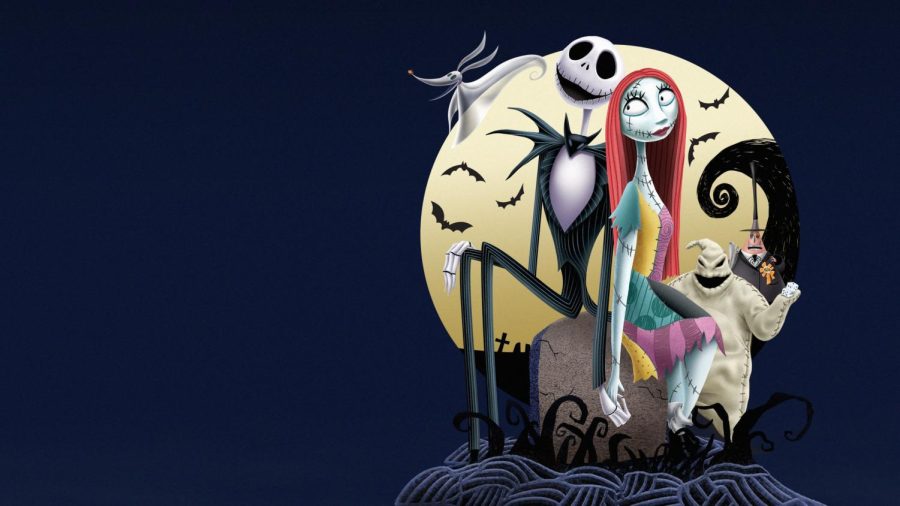A film before hot topic
“Nightmare before Christmas” continues to be a holiday classic nearly 30 years later
November 18, 2022
PG
1hr 16m
10/10
Greetings Schoolcraft students and staff! On the off chance that you’re reading this right now, let me first wish you a Merry Halloween! It’s that exhausting time of year when everyone is either having a party, going to a party or choosing to just forget all of their responsibilities because “hey! It’s a holiday!”
While this time of year can be used as just another excuse to hang out with your fellow human companions, it may also be used as an excuse to have a quiet night in and enjoy a good flick. This writer’s unsolicited recommendation is going to the delightful, underground film (not directed) by Tim Burton: “The Nightmare Before Christmas”!
The film was directed by Henry Selick, known for directing another stop motion Halloween classic “Coraline,” scored by Danny Elfman and animated by Joel Fletcher, Owen Klatte, Angie Glocka and Justin Kohn. “The Nightmare Before Christmas” tells the story of Jack Skellington, a pale, skinny guy trapped in the mundanity of his 9-5 job as the King of Halloweentown. Stuck in a rut, Jack Skellington stumbles upon a magic door that leads him to another holiday universe: Christmas! After Jack discovers that Christmas has better music, he decides to bring it into Halloweentown. Meanwhile a Manic Pixie Dream Girl fawns for Mr. Skellington from a distance.
While a lot of people have seen this movie, few know just how painstaking it was to make. The film took over three years to create; one and a half of those years being spent just on the stop motion alone. Before production had even begun, every single shot of the movie had been storyboarded. Considering that the movie only had a total of 12-17 animators working on production, it’s quite impressive that they were able to get “Nightmare” out in a mere three years. It also might help to explain the movie’s length coming in at only one hour and 16 minutes including the credits.
The meticulous and undoubtedly stressful production, however, doesn’t seem to harm the film in any way.
The pacing is smooth, allowing the catchy songs scored and sung by Elfman to tell the story. The story of “The Nightmare Before Christmas” was inspired by a poem written by Burton who accredited his inspiration to watching Halloween decorations being taken down and replaced by Christmas ones. Seeing both sets of decor side by side got his creative juices flowing. Later on, Burton would develop his poem into a film infamous enough to carry on conversation for decades.
While it can be argued that for a movie that has gained popularity in part due to its darker-than-typical Disney fashion, the story is awfully simple, leaving some questions not completely resolved by the end.
In short, it just works.
Yes, it’s a tale with many twists and turns, but it doesn’t have to be. It’s a simple story about a guy who wants to add a little pizzazz to his life and winds up learning to appreciate who and what he is.
Otherwise, this is a difficult film to criticize or pick apart since everything is just so well put together.
What makes this movie special is the animation and music. Once again, the music tells the story here, not leaving much room between songs. Comparatively, other Disney musicals like “The Lion King” or “Aladdin” use the music not so much to tell the story, but as a tool to convey it. Much like other Disney musicals, the music is fantastic, arguably even more so than others since it is so reliant on it.
Elfman truly brought this film to life. Every song is an earworm you won’t be in such a rush to get out of your head. Some highlight tracks include “This is Halloween” which serves as a perfect opening to the film. Introducing viewers to Halloweentown, complemented by exquisite cinematography by Pete Kozachik.
Another standout track would be “What’s This?” which is played when Skellington discovers Christmastown serving as an excellent contrast both visually and tonally through the song itself. What’s perhaps most impressive about this scene, in particular, is how Chris Sarandon, the voice of Jack Skellington does none of the singing. In the song when he is switching between talking and singing, that’s both him and Elfman going back and forth. It would be easy to mistake them as just one voice actor because of how seamless it is, but nope! Quite an achievement for any movie, especially an animated movie which must have taken some insane coordination on both performers’ parts.
An element of this movie that need not be forgotten is the stunning visuals and animation.
This is a movie that has Burton’s gothic style that has become a popular marketing ploy behind many hot topic shirts and funko pops. The art direction by Henry Selock brings Burton’s style to life through beautiful stop motion which again took an insane amount of effort. This is one movie that could not have been easy to direct, so this is a name to remember. “The Nightmare Before Christmas” has a great visual style that fits wonderfully for this musical. The way that the sets and animation are used as a medium is beautiful and rightfully iconic. Every frame is incredibly detailed and makes this one deserving of many rewatches. There were small progressions like Skelligtons teeth getting sharper, or Sally’s eyes dilating as she watches Skellington from a distance are details many won’t catch in theaters, but add a lot to the movie. Nothing is ever wasted and it is clear why animation was the only way to tell this story.
“The Nightmare Before Christmas” is pretty much flawless. A simple story with astounding imagination. The concept and visuals make this film instantly recognizable giving it a very distinct feel from other animated films. It’s just spooky enough to be intriguing and enjoyed by almost everyone, not scaring anyone off in the process. Elfman is also likely one of the reasons this movie is so timeless as there are eleven songs in a movie that is just a tad over 60 minutes long. Each song moves the story forward while also conveying how the characters are feeling. These are tunes people are still humming almost 30 years later and will likely hum for a hundred more.









